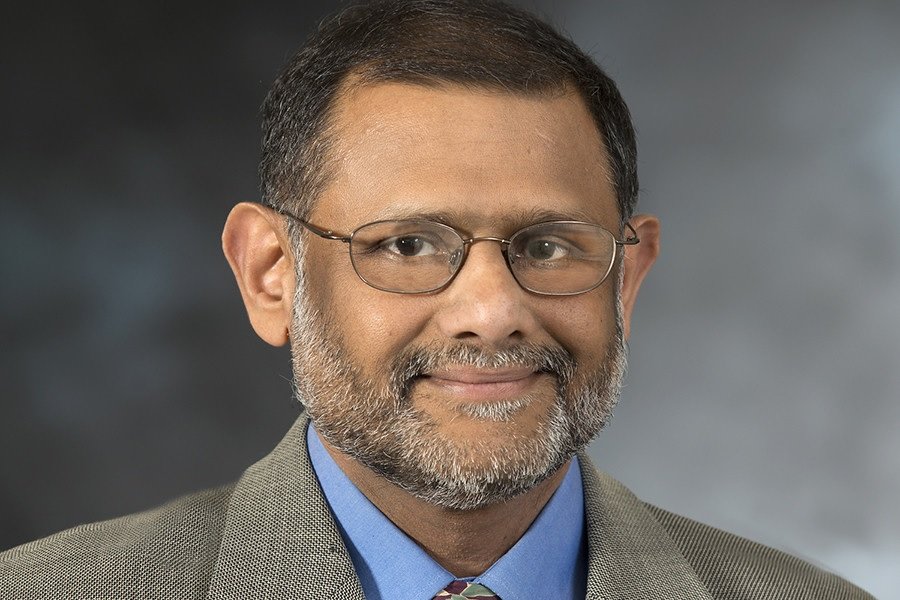Professor Keshab Parhi to be Inducted Fellow of National Academy of Inventors

The following story was posted on June 7, 2021. Since its posting, the National Academy of Inventors held its Fellows Induction Ceremony in Tampa, Florida on November 3, 2021.
Distinguished McKnight University Professor Keshab K. Parhi has been elected as Fellow of the National Academy of Inventors (NAI). The NAI Fellows Selection Committee recognizes that he has “demonstrated a highly prolific spirit of innovation in creating or facilitating outstanding inventions that have made a tangible impact on the quality of life, economic development, and the welfare of society.”
Parhi’s election is richly deserved. It reflects his contributions and commitment to his field of expertise, VLSI architectures and integrated circuit design. He holds 31 US Patents (besides 3 that are pending) in high-speed and low-power transceiver architectures for the internet and cryptosystems, and hardware security. His inventions have fundamentally changed and significantly improved data transmission speeds of communication transceivers. His inventions on pipelining and parallel processing of decision feedback decoders are used by several key technology companies. Parhi’s inventions on low-latency Viterbi decoders, and error control coder architectures are in use in wireless systems. His work on pipelined architectures for the advanced encryption standard (AES) enables millions of secure transactions per second, and his research on polar code decoders and fast Fourier transform are used in smart phones.
Parhi’s work has been of direct significance to companies and users in the communications field. With his research and inventions being licensed and/or assigned to companies such as Broadcom, Infineon, and member companies of the Semiconductor Research Corporation; the impact of his work is felt by anyone using the internet in the speed and secure transactions it offers.
TEACHING AND SERVICE
As a faculty member in the Department of Electrical and Computer Engineering, Parhi has mentored and guided his students on innovation, invention, and the patenting process. It is a testimony of his dedication to his field as a teacher, mentor and researcher that many of his former students have gone on to found or co-found startup companies. In his academic tenure so far, he has supervised 48 doctoral theses, 65 master’s theses, 19 visiting pre- and postdoctoral fellows, and numerous undergraduate senior design projects. His students are employed in technology companies, academic institutions, and government research laboratories.
Parhi has tirelessly volunteered his time and expertise for numerous IEEE and ACM committees. He served as a member of the Board of Governors of the IEEE Circuits and Systems Society (CASS) (2005-2007), and chaired technical and awards/fellow committees of IEEE, and IEEE CASS. He was editor-in-chief of IEEE Transactions on Circuits and Systems (2004-2005) and associate editor 14 times. He has also served as general chair, technical program chair, and program committee member for several conferences. He served as Director of Graduate Studies of the Electrical Engineering Program at the University from 2008 to 2011.
CAREER ARC
Prof. Keshab Parhi joined the University of Minnesota in 1988 having completed his PhD in September 1988 at the University of California, Berkeley. He is Edgar F. Johnson Professor of Electronic Communication and Distinguished McKnight University Professor. He has worked with key technology companies such as Broadcom, Medtronic, and others while on leave from the University. In 2005, he founded Leanics Corporation, and was CEO/CTO from 2005 to 2012. The company was awarded four SBIR Phase-I grants and one SBIR Phase-II contract. It raised over $1.3M and employed several of his PhD students.
Prof. Parhi has been the recipient of numerous awards in recognition of his research and service contributions. His most recent awards include the Mac Van Valkenburg Award from IEEE CASS (2017); Fellow of the American Association for the Advancement of Science (2017); Distinguished Alumnus Award from alma mater IIT, Kharagpur, India (2013); Graduate/Professional Teaching Award, University of Minnesota (2013); Charles A. Desoer Technical Achievement Award from IEEE CASS (2012); IEEE Kiyo Tomiyasu Technical Field Award (2003); IEEE W.R.G. Baker Best Paper Award (2001); and the IEEE CASS Golden Jubilee Medal (2000). These, of course, are only a few of the awards Parhi has received in a career that is studded with numerous honors that speak to his brilliance and commitment to research, invention, and teaching. The Department of Electrical and Computer Engineering is proud of Professor Parhi’s achievements and congratulate him on his induction as Fellow of the NAI.
With this recognition, Parhi will join the ranks of five University of Minnesota faculty who are Fellows of NAI, including Prof. Georgios Giannakis from ECE, who was inducted in 2019.
Founded in 2010, the NAI is a member organization comprising domestic and foreign universities, and government and non-profit research institutes. It has over 4,000 individual inventor members and Fellows spanning more than 250 institutions worldwide. Its goal is to “recognize and encourage inventors with patents issued from the U.S. Patent and Trademark Office, enhance the visibility of academic technology and innovation, encourage the disclosure of intellectual property, educate and mentor innovative students, and translate the inventions of its members to benefit society.”